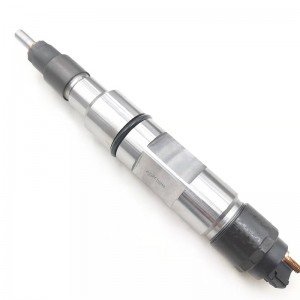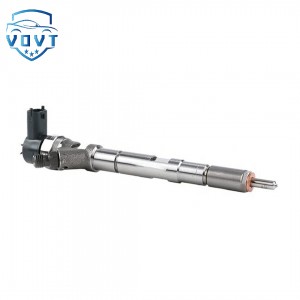Professional Manufacture 0 445 120 007 Diesel Injector Common Rail Injector Engine Parts Vehicle Parts 0445120007
products description
| Reference. Codes | 0 445 110 748 |
| Application | / |
| MOQ | 4PCS |
| Certification | ISO9001 |
| Place of Origin | China |
| Packaging | Neutral packing |
| Quality Control | 100% tested before shipment |
| Lead time | 7~10 working days |
| Payment | T/T, L/C, Paypal, Western Union, MoneyGram or as your requirement |
Research on Optimization of Injection Characteristics of High-Pressure Common Rail Injector
The optimization of injection characteristics of high-pressure common rail injectors is the core direction to improve diesel engine fuel economy and reduce emissions. Its core goal is to achieve precise control of injection pressure, rate, and timing through multidisciplinary cross-cutting means. The following analysis is carried out from three dimensions: research methods, key technologies, and the latest progress:
Research methods: multi-physics field coupling modeling and intelligent optimization algorithm
Multi-physics field coupling modeling
Based on the electro-magnetic-mechanical-hydraulic coupling theory, establishing an injector dynamic response model is the basis for optimization. For example, the research of the China Internal Combustion Engine Society took the Bosch injector as the object and constructed a coupling model including the dynamic characteristics of the high-speed solenoid valve, the needle valve motion equation, and the fuel flow continuity equation. The accuracy of the model under different rail pressures (80-160MPa) was verified through experiments, and the error was controlled within ±3%. Similarly, the team of Northwestern Polytechnical University established a mathematical model for the coordinated work of the supercharging device and the injector for the ultra-high pressure common rail system, revealing the influence of the injection pulse width (0.6-1.4ms) and the boost pulse width (0.5-2ms) on the injection rate curve shape, and found that the "inverted boot-shaped" curve may appear under a large injection pulse width, which is directly related to the boost pressure fluctuation.
Application of intelligent optimization algorithm
Improved genetic algorithm (GA) and multi-objective optimization methods are widely used for parameter optimization. For example, a study combined GA with a coupling model, with the goal of minimizing the needle valve response time (TN) and maximizing the injection efficiency (η), and generated 120 sets of simulation samples through D-optimal experimental design (DOE). After constructing the response surface model, the Pareto optimal solution set was obtained, which ultimately shortened TN by 18% and increased η by 12%. Another study proposed a self-learning method, using the recursive least squares method to identify the injector metering characteristic model online, and dynamically adjust the injection pulse width by collecting rail pressure fluctuation data, so as to achieve the control accuracy of the cycle injection amount within the whole life cycle to ±1.5%.
Key technologies: structural optimization and control strategy innovation
Structural parameter refinement design
Oil channel characteristic decoupling: The study found that the oil channel length-to-diameter ratio (L/D) and the oil tank volume inside the injector are the main causes of pressure fluctuations. By reducing L/D from 5:1 to 2:1 and the oil tank volume from 0.1cm³ to 0.05cm³, the fluctuation amplitude of the main injection amount can be reduced from 3.6mm³ to 1.7mm³, and the coupling degree can be reduced by 53%.
Cooperative optimization of supercharging device: In the ultra-high pressure common rail system, the oil outlet diameter (0.2-0.4mm) and the valve core displacement (0.8-1.2mm) have a significant impact on the supercharging effect. Experiments show that when the oil outlet diameter increases to 0.35mm and the valve core displacement reaches 1.0mm, the peak pressure of the boost chamber increases by 25%, the injection rate curve changes from "boot-shaped" to "rectangular", and the atomization fineness (Sauter average diameter) decreases from 35μm to 22μm.
Control strategy innovation
Multi-stage injection timing optimization: The coordinated adjustment of the pre-injection interval (5-15°CA) and the main injection ratio (70-90%) can improve the combustion phase. For example, a marine diesel engine was optimized by a micro-genetic algorithm, shortening the pre-injection interval from 10°CA to 8°CA, increasing the main injection ratio from 85% to 90%, reducing NOx emissions by 21.27%, and reducing soot concentration by 18%.
Pressure fluctuation suppression technology: In view of the superposition effect of pressure waves in multiple injections, a "dynamic leakage compensation" strategy is proposed. By adding a 0.1ms pulse discharge after the main injection, the pressure fluctuation amplitude of the oil tank can be reduced from 12MPa to 5MPa, and the injection consistency can be improved by 40%.
Latest progress: Intelligent and ultra-high pressure technology breakthroughs
Intelligent control
Dynamic regulation based on AI has become a research hotspot. For example, a team has developed a controller that integrates BP neural network and fuzzy PID, collects 12 parameters such as cylinder pressure and rail pressure in real time, and predicts the best injection strategy through cloud model. Under 1500r/min and 75% load conditions, the system reduces fuel consumption by 6% and smoke value by 25%.
Ultra-high pressure injection technology
The application of ultra-high pressure common rail system (rail pressure ≥ 2000bar) promotes the optimization of injection characteristics. The booster designed by the Naval University of Engineering can amplify the fuel pressure to 2500bar. By adjusting the opening time of the boost solenoid valve (1.5-3.5ms), the injection rate curve can be flexibly switched from "single peak" to "double peak". Under the common rail pressure of 100MPa, the spray penetration distance is shortened by 12% and the atomization cone angle is increased by 15°.
Experimental verification and engineering application
Visual experimental platform
The combination of high-speed photography (100,000 frames/second) and laser particle size analyzer (Malvern Spraytec) can be used to simultaneously observe the spray morphology and particle size distribution. For example, the transparent nozzle experiment shows that when the aspect ratio of the nozzle hole (6-10) increases, the cavitation intensity increases by 30%, but the excessively long nozzle hole (L/D>8) will cause the jet breakup delay, and the average Sauter diameter increases from 25μm to 35μm.
Actual machine test results
After a heavy-duty diesel engine is equipped with an optimized injector, it achieves the following under ESC13 conditions:
Economy: Fuel consumption rate is reduced by 8.2% (from 205g/kWh to 188g/kWh)
Emission: NOx + soot emission product is reduced by 35%, meeting Euro VIb standard
Reliability: After 500 hours of durability test, the nozzle wear is < 5μm, and the solenoid valve response time decay is < 5%
Challenges and future directions
Current bottlenecks
High-frequency response limitation: The existing solenoid valve response time (0.3-0.5ms) is difficult to meet the rapid pressure building requirements of the ultra-high pressure common rail system (>2000bar)
Multi-objective conflict: Increasing the injection pressure (>1800bar) will aggravate the nozzle wear, while reducing the oil channel diameter (<0.2mm) may cause cavitation corrosion
Frontier exploration
Material innovation: Using tungsten carbide-cobalt coating (thickness 20-30μm) can increase the wear resistance of the nozzle hole by 5 times and extend the service life from 500 hours to 2500 hours
Digital twin technology: Based on the Unity engine, a virtual debugging platform for injectors can be built to predict the injection characteristics under different parameter combinations during the design phase, shortening the development cycle by 30%
Through the above technical path, the research on the optimization of injection characteristics of high-pressure common rail injectors is evolving from single parameter adjustment to "structure-control-material" collaborative optimization, providing solid technical support for the efficient and clean combustion of diesel engines.
Related products
| 1 | 5WS40200 | 11 | A2C59514909/ | 21 | 31336585 |
| 2 | FA2C53252642 | 12 | A2C59511602 | 22 | 36001726 |
| 3 | 1685796 | 13 | A2C59513556 | 23 | 1709667 |
| 4 | 31303994 | 14 | 5ws40677 | 24 | 36001727 |
| 5 | 50274V05 | 15 | 50274V0 | 25 | 9445R |
| 6 | 5WS40087 | 16 | 5WS40677 | 26 | 00Q1T |
| 7 | 16600-00Q1T | 17 | AV6Q9F593-AB | 27 | 5WS40007 |
| 8 | 00Q0H | 18 | AV6Q9F593-AA | 28 | A2C59513997 |
| 9 | 5WS40148-Z | 19 | A2C59511606 | 29 | 5WS40250 |
| 10 | 2S6Q-9F593-AB | 20 | 16600-00Q0P | 30 | A2C59514912 |























